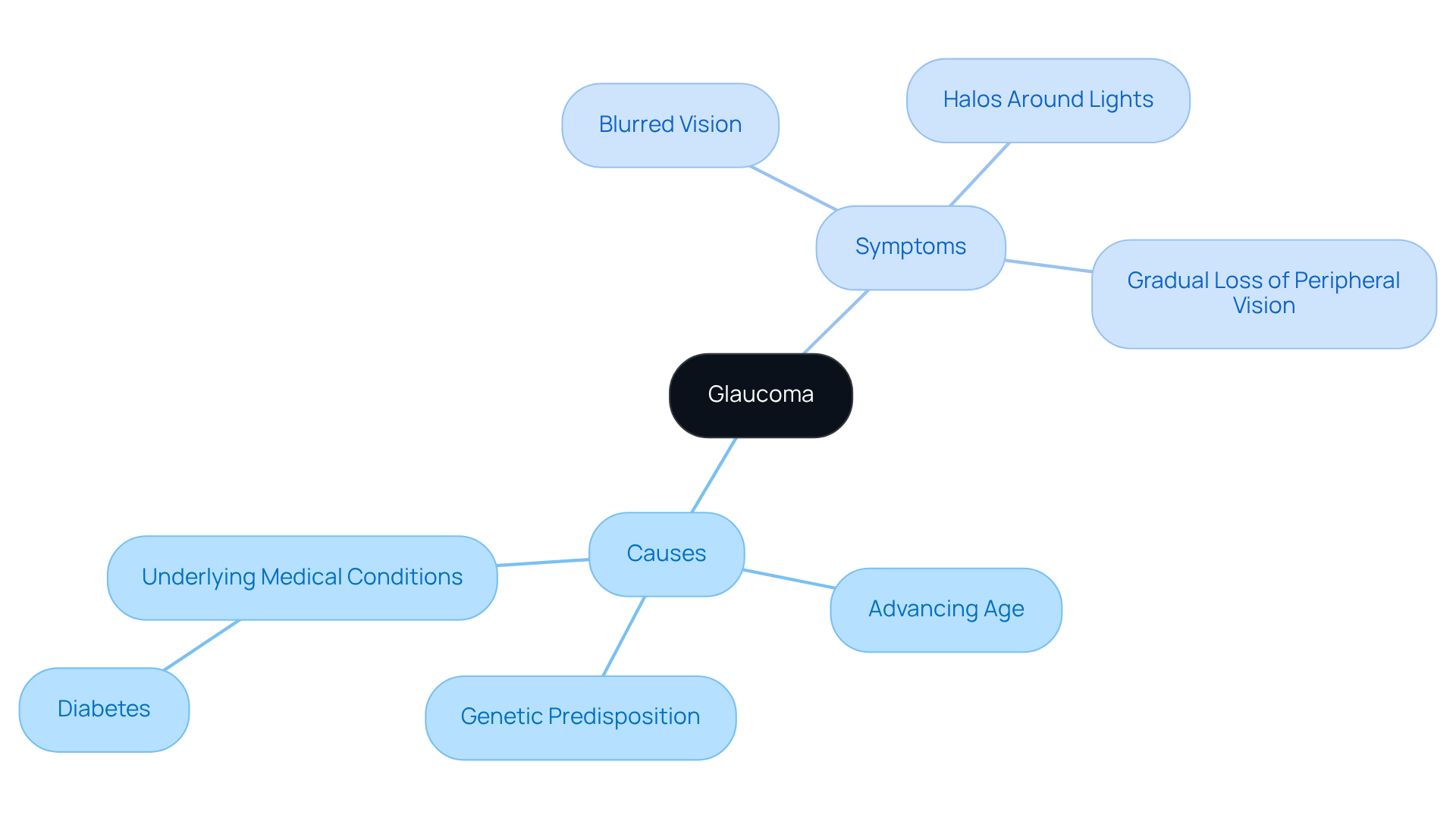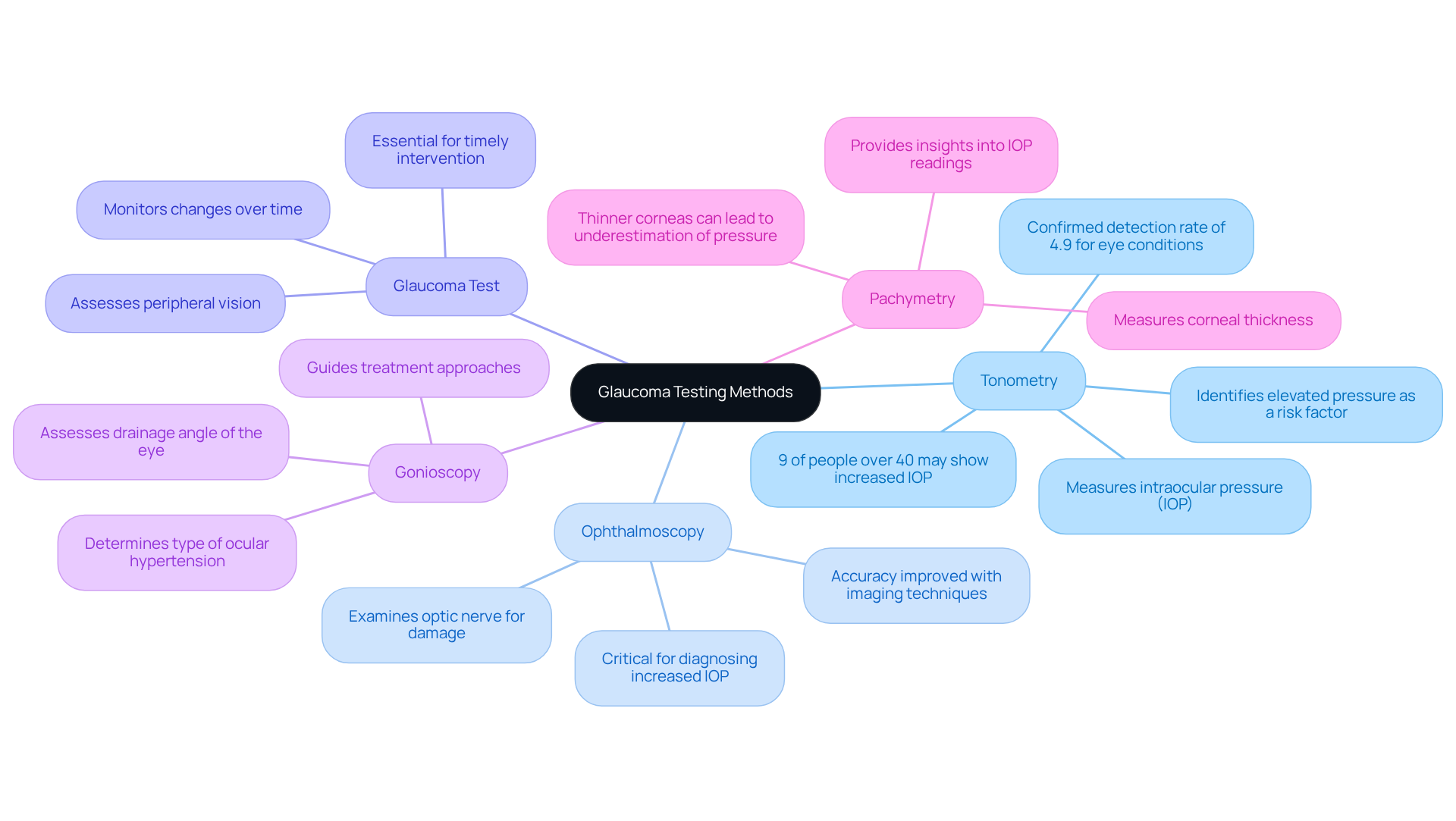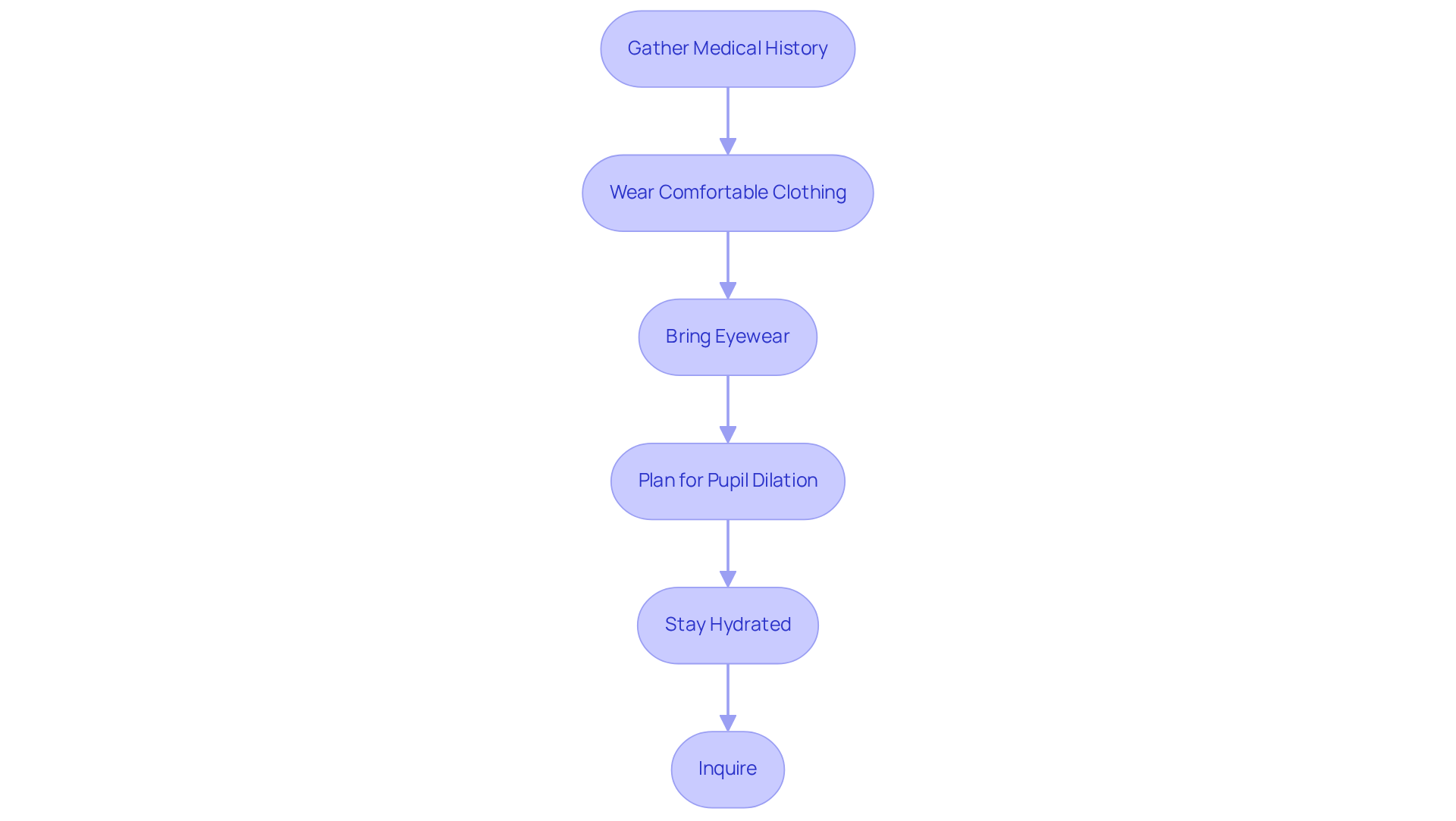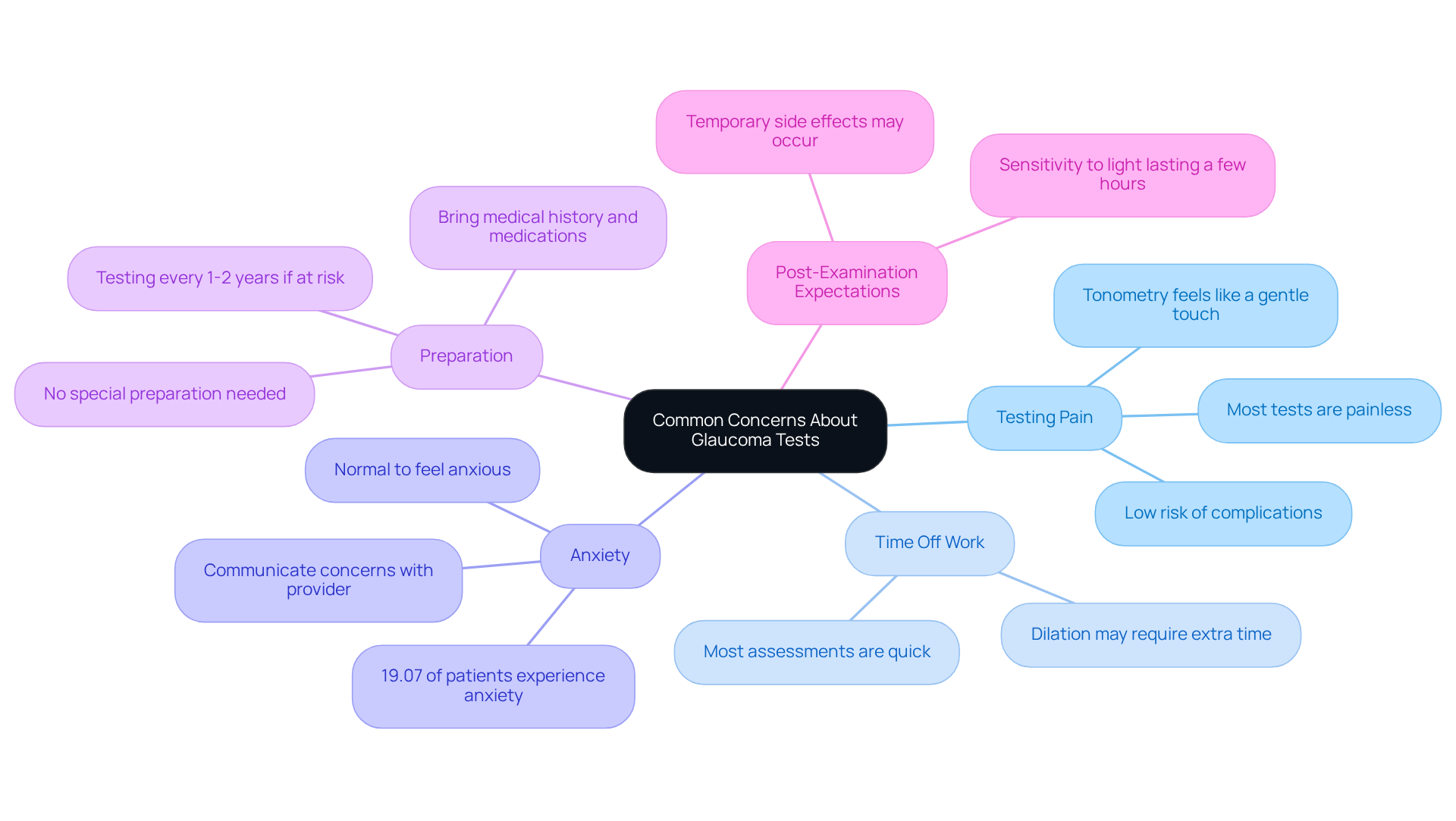Posted by: Northwest Eye in General on July 15, 2025
Overview
We understand that preparing for your glaucoma test can feel overwhelming. To help ease any anxiety, it’s essential to:
- Gather your medical history
- Wear comfortable clothing
- Bring your eyewear
- Plan for pupil dilation if necessary
Taking these steps not only reduces stress but also ensures a comprehensive examination.
This thorough approach is crucial for the early detection and effective management of glaucoma, a condition that affects millions who may be unaware of their diagnosis. Remember, we are here to help you through this process, and your well-being is our priority.
Introduction
Understanding the nuances of glaucoma is crucial, especially since millions are at risk of developing this sight-threatening condition without even realizing it. We recognize that this can be a daunting reality.
This article serves as a comprehensive guide for individuals preparing for a glaucoma test, offering essential steps to ensure a smooth experience and effective evaluation. It’s common to feel anxious about the testing process, but we want to emphasize the importance of early detection.
By addressing common concerns and providing practical preparation tips, we aim to empower you to take charge of your eye health and face your glaucoma test with confidence.
Understand Glaucoma: Causes and Symptoms
Glaucoma includes various eye diseases that can harm your optic nerve, primarily due to elevated intraocular pressure (IOP). We understand that learning about this can be concerning, especially with key risk factors like:
- Genetic predisposition
- Advancing age
- Underlying medical conditions such as diabetes
In the U.S., around 1.49 million adults face vision-impairing eye diseases, and significantly, about 10% of individuals with IOP over 21 mm Hg may develop glaucoma within five years.
It’s common to feel uncertain, especially since the early stages of glaucoma often show no visible symptoms. This makes awareness crucial. As the disease advances, you might experience:
- Blurred vision
- Halos around lights
- A gradual loss of peripheral vision
Recognizing these symptoms is vital for timely intervention.
We encourage , particularly glaucoma tests, for those over 40 or with risk factors. By understanding these aspects of glaucoma, you can take proactive steps in managing your eye health and seeking necessary medical attention. Remember, we are here to help you through this process and ensure you receive the support you need.

Explore Glaucoma Testing Methods
A glaucoma test encompasses a variety of methods designed to evaluate eye health comprehensively. We understand that navigating eye health can be concerning, and we are here to help you through this process. Key tests include:
- Tonometry: This essential test measures intraocular pressure (IOP) using a device that gently contacts the eye. It is crucial for recognizing elevated pressure, a major risk factor for eye disease. Research suggests that although 9% of people over 40 might display increased IOP, only 1 in 50 will truly have the condition. This highlights the necessity for in the glaucoma test. The Early Manifest Glaucoma Trial (EMGT) discovered a verified detection rate of 12.1% for the condition, underscoring the importance of the glaucoma test in routine eye examinations.
- Ophthalmoscopy: This procedure enables the eye care specialist to closely examine the optic nerve for signs of damage, which is critical in diagnosing increased intraocular pressure and performing a glaucoma test. Current data suggests that the accuracy of ophthalmoscopy in detecting optic nerve damage is enhanced when combined with other imaging techniques. Experts emphasize that this combination significantly improves diagnostic accuracy.
- Glaucoma Test: This evaluation, which examines peripheral vision, assists in recognizing any loss that may signal the advancement of eye disease. It is particularly effective in monitoring changes over time, allowing for timely intervention. We understand that this can feel overwhelming, but it is essential for your eye health.
- Gonioscopy: This examination assesses the drainage angle of the eye, which is essential for comprehending the type of ocular hypertension and determining the most effective treatment approach, including conducting a glaucoma test. Knowing this can help ease your concerns about the condition.
- Pachymetry: By measuring corneal thickness, this procedure offers valuable insights into IOP readings, as thinner corneas can lead to underestimation of pressure levels.
Each of these evaluations, such as the glaucoma test, is essential for diagnosing the condition and creating a suitable treatment strategy. The advancements in eye disease diagnostic tests, particularly the glaucoma test along with optical coherence tomography (OCT) and fundus photography, have significantly improved detection rates, ensuring that patients receive timely and effective care. Real-world uses of tonometry have proven its dependability, with research indicating a confirmed detection rate of 4.9% for eye conditions among screened individuals. This highlights its significance in regular eye examinations. Additionally, the occurrence of this eye condition among Canadians aged 40-79 varies from 0.7% to 10.3%, further emphasizing the necessity of regular eye health assessments. Remember, we are here to support you every step of the way.

Prepare for Your Glaucoma Test: Essential Steps
To ensure a successful glaucoma test, we recognize that preparation can feel overwhelming. Here are some essential steps to help you feel more at ease:
- Gather Medical History: Compile a comprehensive list of medications you are currently taking, along with your medical history, particularly any previous eye conditions. This information is crucial for your ophthalmologist to make informed decisions regarding your care.
- Wear Comfortable Clothing: Opt for , as you may spend an extended period in the testing facility. Comfort can help reduce anxiety and allow you to focus on the examination.
- Bring Eyewear: If you wear glasses or contact lenses, make sure to bring them for the examination. Accurate vision correction is vital for effective testing.
- Plan for Pupil Dilation: If your examination involves pupil dilation, arrange for someone to drive you home afterward. Dilation can temporarily affect your vision, making it unsafe to drive.
- Stay Hydrated: Consume water prior to your appointment to remain hydrated, but steer clear of excessive fluid consumption immediately before the procedure to avoid heightened eye pressure, which can influence outcomes.
- Inquire: Prepare any questions you may have regarding the assessments or your eye health. Engaging with your ophthalmologist can provide clarity and enhance your understanding of your condition.
By following these steps, you can help ensure that your eye examination, which includes a glaucoma test, is comprehensive and effective, contributing to better management of your eye health. Remember, around 4.22 million individuals in the U.S. have this eye disease, with nearly half unaware of their condition. Regular eye exams are crucial for early detection, as emphasized by experts like Dr. Lisa M. Young, who notes that understanding your eyesight is vital for maintaining overall health. Utilizing resources such as the Eye Condition Library can empower you with knowledge about your condition before your appointment.

Address Common Concerns About Glaucoma Tests
Many individuals have concerns regarding eye examinations, and it’s important to address these feelings. Here are some common worries along with clarifications:
- Is the testing painful? Most glaucoma tests are painless. For instance, tonometry may feel like a gentle touch or a puff of air. The risk of complications from eye examinations is typically quite low, which can help ease concerns about safety.
- Will I need to take time off work? Most assessments are quick; however, if dilation is involved, you may need to allow some extra time for your vision to return to normal.
- What if I have anxiety about the tests? It’s completely normal to feel anxious. Research shows that individuals with eye pressure issues often experience higher rates of anxiety (19.07%) and depression (19.42%). We encourage you to ; they can guide you through the process and offer reassurance.
- Do I need to prepare in any special way? Generally, no special preparation is required, but bringing your medical history and current medications can be helpful. If you are at heightened risk for eye pressure disorders, you may need a glaucoma test every 1-2 years.
- What should I expect after the examination? Some patients may experience temporary side effects, such as sensitivity to light, lasting a few hours after dilation.
By addressing these concerns, we hope you feel more confident and informed as you approach your glaucoma test. Remember, we are here to help you through this process.

Conclusion
Understanding the intricacies of glaucoma and the importance of testing is crucial for maintaining eye health. We understand that the thought of glaucoma can be concerning, but being proactive is essential. Regular eye examinations and various testing methods can lead to early detection and effective management of this condition.
Key points discussed include:
- The causes and symptoms of glaucoma
- The various testing methods available
- Essential preparation steps to take before a glaucoma test
By gathering your medical history, wearing comfortable clothing, and addressing common concerns, you can approach your glaucoma tests with confidence and clarity. It’s common to feel anxious about the process, but open communication with your eye care provider can alleviate those feelings and ensure you understand every step.
Ultimately, regular eye exams and knowledge about glaucoma are vital components in preserving your vision and overall health. Taking action by preparing for glaucoma tests and staying informed can lead to better outcomes and a proactive approach to eye care. We encourage you to embrace the opportunity to prioritize your eye health and inspire others to do the same. Remember, early detection can make a significant difference in managing this potentially sight-threatening condition.
Frequently Asked Questions
What is glaucoma?
Glaucoma refers to a group of eye diseases that can damage the optic nerve, primarily due to elevated intraocular pressure (IOP).
What are the key risk factors for developing glaucoma?
Key risk factors for glaucoma include genetic predisposition, advancing age, and underlying medical conditions such as diabetes.
How prevalent is glaucoma in the U.S.?
In the U.S., around 1.49 million adults face vision-impairing eye diseases, and about 10% of individuals with IOP over 21 mm Hg may develop glaucoma within five years.
What are the early symptoms of glaucoma?
The early stages of glaucoma often show no visible symptoms, which is why awareness is crucial.
What symptoms may indicate the advancement of glaucoma?
As glaucoma advances, symptoms may include blurred vision, halos around lights, and a gradual loss of peripheral vision.
Why is it important to recognize symptoms of glaucoma?
Recognizing the symptoms of glaucoma is vital for timely intervention and management of the disease.
Who should get regular eye examinations for glaucoma?
Regular eye examinations, particularly glaucoma tests, are encouraged for individuals over 40 or those with risk factors.






